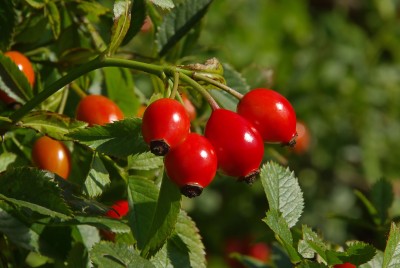Dog Rose

Common Names: Dog Rose, Wild Rose, Rosehip, Rosa canina, Eglantine, Sweet Briar, European Wild Rose, Rosier des chiens, Cynorrhodon, Rosa sylvestris, Rubiginosa, Schroder's rose, Hound's rose
Latin Name: Rosa canina
Origin: Africa, Asia, Europe, South America, North America
Short Introduction
In the Czech Republic, the Dog Rose thrives remarkably well and is even sometimes considered a weed. Generally, this plant is resilient, but heavy clay soil, excessive moisture, or persistently shaded locations can hinder its growth. Propagation is possible by root cuttings, offshoots, or segments of roots left in the soil, from which new shoots emerge during the growing season. The plant tolerates ordinary soil, but prefers sunny locations.
Detailed Description
A classic European herb with many uses and a lovely fragrance.
Botanical Information
The Dog Rose (Rosa canina) is a deciduous shrub that can reach heights of up to 3 meters, although it usually ranges from 1 to 2.5 meters, or occasionally grows as a climbing vine, able to surpass the height of some trees. Its trunk is covered in small, sharp (sometimes hook-shaped) thorns that assist its climbing, along with long shoots. Stems are thorny, slightly arching, or upright. The leaves are alternate, stalked, and pinnate, comprised of five to seven smaller lanceolate-to-elliptical leaflets, with finely serrated, slightly pointed edges, measuring 2–4 cm in length and 1–2.5 cm in width.
The flowers are 4–6 cm in diameter, usually light pink but can vary from white to deep pink, with five petals. Blossoming occurs in May and June, maturing into 1.5–2 cm long, red-to-orange fruits, known as rose hips, which ripen from August to September. Inside, the hips are filled with seeds surrounded by fine, irritating hairs. Rose hips are resilient to frost.
Origin and Distribution
Dog Rose is widespread throughout almost all of Europe, except in the farthest northern regions, and is also native to North Africa and neighboring western Asia. It grows on sunny borders, slopes, woodland edges, from lowlands to mountainous areas, up to altitudes of 1200 meters. It prefers calcareous, deeper soils, as its roots penetrate relatively deeply.
Usage / Dosage
Historically, Dog Rose was used to scent wash-water and as a culinary ingredient. There was even a dish called rosée where the rose was paired with fish for flavor. Today, it continues to be used in cooking as an aromatic addition. The edible rose hips are commonly used to make tea, syrup, preserves, compote, homemade wine, or liqueur.
During World War II, Dog Rose was planted across America as a symbol of victory, and many can still be found in these locations. In Bulgaria, where the Dog Rose has naturalized, it is used for homemade wine to support immunity, while in Austrian folk medicine, rose hip tea is recommended for viral infections and urinary tract inflammation.
Rose hips contain a high concentration of vitamin C, making rosehip tea a traditional remedy for strengthening the body. It is especially valued for the prevention of colds and bacterial or viral infections. It also strengthens blood vessel walls, aiding in the prevention of edema and symptoms of inflammation, and supports vascular health in those with physically demanding jobs. Thanks to the potent antioxidant vitamin C content, Dog Rose earns recognition as a powerful antioxidant herb. Its ability to support overall immunity is acknowledged not only by traditional medicine, but also by results and statistics from some laboratory research.
Dog Rose and its decoction have mild diuretic effects, so it is recommended to drink at least 1 liter of water alongside. The herb slightly lowers blood pressure and helps reduce mild swelling. It aids in filtering the kidneys and cleansing the urinary system. Some studies are examining the plant's constituents and their effects in managing kidney and urinary tract inflammation, with positive results so far. Similarly, studies are showing promise in their influence on supporting respiratory health and overall lung function.
Dog Rose is traditionally regarded as calming, helping reduce spring fatigue, improve concentration and prolong periods of mental focus. Its constituents, especially the high vitamin C and flavonoid content, impart a mild astringent effect to support digestive function, prevent digestive issues such as bloating or diarrhea, and promote relief when such problems occur. The same compounds promote prothrombin formation and are therefore useful for stopping bleeding and promoting healing of surface wounds.
Compounds in Dog Rose reduce plasma cholesterol and free fatty acid concentrations and decrease vascular atherosclerotic plaque formation. They also strengthen capillaries, reducing edema risk and other swelling. In folk medicine, Dog Rose is also used for bone fractures to support healing, for vitamin deficiencies, for diabetes, pertussis, fatigue, dysentery, heavy or painful menstruation, urination problems, hemorrhoids, vein disorders, hemoptysis, and watery eyes.
Active Compounds
The plant material contains 0.2–1% vitamin C content (dry weight; most vitamin C is lost during drying), carotenoids, B vitamins (B1, B2), vitamin K, flavonoids, organic acids (citric, malic, nicotinic acids), sugars, mucilage, pectin, and minerals.
Traditional Dosage
Tea is made from dried, crushed, or whole fruits, dosing about 2 teaspoons per 250 ml of water. To boost vitality, rosehip liqueur (from 1 kg hips, 0.5 kg sugar, 3 liters alcohol) is sipped as 1 small glass daily before meals. For syrup, blend 200 g flowers, 3 kg sugar, and 2.2 liters water, then mix in 150 g of 60% alcohol.
